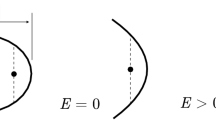Abstract
We determine the foliations of the phase space of four particular integrable Hamiltonian systems obtained from the Kepler problem, namely the sidereal and the synodical Kepler Problem in the plane \({(\mathbb{R}^{2})}\) and in the space \({(\mathbb{R}^{3})}\). These problems differ in their formulation by the choice of the referentials and by the dimension of the phase space. These four Kepler problems have played a main role in Celestial Mechanics. Their importance is justified: First, the study of an integrable problem allow us to obtain information about a non-integrable problem sufficiently close to the integrable one. In fact this is the principle of perturbation theory. Second, from the point of view of the applications, the sidereal is basic for the computation of the planetary ephemerides and the synodical is the limit case of the non-integrable restricted circular 3-body problem when one of the masses of the two primaries tends to zero. We determine the foliations of the phase space of these four Kepler problems by the orbits (i.e. we characterize their global flow), and by fixing one, two or three independent first integrals in involution; of course, at most three for the two spatial problems, and at most two for the two planar problems.
Similar content being viewed by others
References
Abraham R., Marsden J.E.: Foundations of Mechanics. Benjamin, Reading (1978)
Albouy A.: Integral manifolds of the n-body problem. Invent. Math. 114, 463–488 (1993)
Arnold, V.I.: Mathematical Methods of Classical Mechanics. MIR, Moskow (1975, in Russian). Springer, Berlin (1978, in English)
Arnold V.I., Kozlov V.V., Neishtadt A.I.: Dynamical Systems III, Enyclopaedia of Mathematical Sciences. Springer, Berlin (1978)
Birkhoff G.D.: Dynamical Systems. AMS, New York (1927)
Cabral H.: On the integral manifolds of the n-body problem. Invent. Math. 20, 59–72 (1973)
Casasayas J., Llibre J.: Qualitative analysis of the anisotropic Kepler problem. Mem. Am. Math. Soc. 52, 312 (1984)
Casasayas J., Martinez Alfaro J., Nunes A.: Knots and links in integrable Hamiltonian systems. J. Knot Theory Ramif. 7, 123–153 (1998)
Devaney R.: Collision orbits in the anisotropic Kepler problem. Invent. Math. 45, 221–251 (1978)
Devaney R.: Singularities in classical mechanics systems. In: Katok, A. (eds) Ergodic Theory and Dynamical Systems I. Proceedings Special Year, Maryland 1979–1980, pp. 211–333. Birkhäuser, Basel (1981)
Easton R.W.: Some topology of 3-body problems. J. Differ. Equ. 10, 371–377 (1971)
Easton R.W.: Some topology of n-body problems. J. Differ. Equ. 19, 258–269 (1975)
Fomenko, A.T.: On typical topological properties of integrable Hamiltonian systems. Izv. Akad. Nauk (SSSR) Ser. Mat. 52, 378–407 (1988); English Transl. in Math. USSR Izv. 32 (1989)
Fomenko, A.T.: Differential equations and applications to problems. In: Francaviglia, M. (ed.) Physics and Mechanics. Mechanics Analysis and Geometry: 200 Years after Lagrange. Elsevier, Amsterdam (1991)
Guillemin V., Pollack A.: Differential Topology. Prentice-Hall, Englewood Cliffs (1974)
Hirsch M.W.: Differential Topology. Springer, Berlin (1976)
Hirsch, M., Pugh, C., Shub, M.: Invariant Manifolds. Lecture Notes in Mathematics, vol. 583. Springer, Berlin (1977)
Kaplan W.: Topology of the two-body problem. Am. Math. Mon. 49, 316–326 (1942)
Liouville J.: Sur l’integration des équations différentielles de la Dynamique, présentée au Bureau des Longitudes le 29 de juin 1853. J. Math. Pures Appl. 20, 137–138 (1855)
Llibre J.: On the restricted three-body problem when the mass parameter is small. Celest. Mech. 28, 83–105 (1982)
Llibre J., Martinez Alfaro J.: Ejection and collision orbits of the spatial restricted three-body problem. Celest. Mech. 35, 113–128 (1985)
Llibre J., Nunes A.: Separatrix surfaces and invariant manifolds of a class of integrable Hamiltonian systems and their perturbations. Mem. Am. Math. Soc. 107, 513 (1994)
Llibre J., Piñol C.: On the elliptic restricted three-body problem. Celest. Mech. 48, 319–345 (1990)
Llibre, J., Soler, J.: Global flow of the rotating Kepler problem. In: Hamiltonian System and Celestial Mechanics, Advanced Series in Nonlinear Dynamics, vol. 4, pp. 125–140. World Scientific, Singapore (1993)
McCord C.K., Meyer K.R., Wang Q.: The integral manifolds of the three body problem. Mem. Am. Mat. Soc. 132, 628 (1998)
McGehee R.: A stable manifold theorem for degenerate fixed points with applications to celestial mechanics. J. Differ. Equ. 14, 70–88 (1973)
McGehee R.: Triple collision in the collinear three-body problem. Invent. Math. 27, 191–227 (1974)
Meyer, K.R., Hall, G.: Introduction to Hamiltonian dynamical systems and the n-body problem. In: Applied Mathematical Sciences, vol. 90. Springer, New York (1992)
Moser J.: Stable and Random Motion in Dynamical Systems. Princeton University Press, Princeton (1973)
Roy A.E.: Orbital Motion. Wiley, New York (1978)
Smale S.: Topology and Mechanics, I. Invent. Math. 10, 305–331 (1970)
Smale S.: Topology and mechanics, II. The planar n-body problem. Invent. Math. 11, 45–64 (1970)
Sotomayor, J.: Lições de Equações Diferenciais Ordinárias. Projeto Euclides, IMPA, Rio de Janeiro (1979)
Stiefel E.L., Scheifelle G.: Linear and Regular Celestial Mechanics. Springer, Berlin (1971)
Szebehely V.: Theory of Orbits. Academic Press, New York (1967)
Author information
Authors and Affiliations
Corresponding author
Additional information
M. P. Dantas was supported by a CAPES grant. J. Llibre was supported by a MEC/FEDER grant number MTM2008-03437 and by a CICYT grant number 2009SGR 410.
Rights and permissions
About this article
Cite this article
Dantas, M.P., Llibre, J. The Global Phase Space for the 2- and 3-Dimensional Kepler Problems. Qual. Theory Dyn. Syst. 8, 45 (2009). https://doi.org/10.1007/s12346-009-0002-0
Received:
Accepted:
Published:
DOI: https://doi.org/10.1007/s12346-009-0002-0



